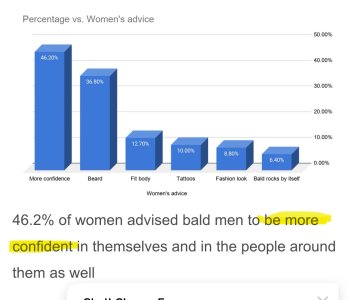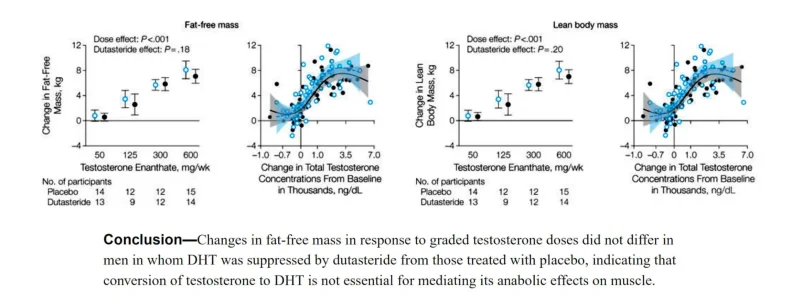- Joined
- Sep 16, 2025
- Messages
- 1,284
- Reaction score
- 2,014
- Points
- 173
Abstract
Male pattern baldness remains a significant aesthetic concern. Evidence indicates that women generally prefer men with hair, though biased surveys sometimes claim otherwise. This article reviews current treatments such as finasteride, dutasteride, and minoxidil; emerging molecules like PP405; stem cell therapy; and the role of androgens in accelerating loss.
Introduction
Balding alters facial framing, reveals unideal skull shapes, and symbolizes aging. Most women, when asked to choose, prefer men with hair in at least 8 out of 10 cases. However, some media surveys suggest baldness can be “more attractive.” For example, one frequently cited study of ~1,000 women concluded that bald men were seen as more attractive and appealing than their none bald peers . Yet this survey was funded by a company that sells head shavers, raising clear conflict-of-interest concerns.
And when the women were asked how men could be most attractive embracing this bald look, they were told to “just be confident” - read, “just look like Jeremy Meeks”. JFL.

Anecdotally and statistically, the stronger trend remains: hair is preferred over baldness.
Current Pharmacological Strategies
Finasteride / Dutasteride
Minoxidil
Emerging Molecules
PP405 (Investigational)
A novel molecule targeting metabolic pathways in hair follicle stem cells:
If successful, PP405 would represent a paradigm shift—moving beyond prevention to genuine follicular regeneration.
Stem Cell Therapies
Androgens and Hair Loss
While DHT is a major driver of male pattern baldness, it is not the whole story. All androgens that bind strongly to scalp androgen receptors can contribute to hair loss.
Inference:
If you are genetically predisposed to baldness and considering supraphysiological AAS use, weigh the trade-off carefully. Without consistent access to anti-androgen strategies (finasteride, dutasteride, RU58841, possibly PP405 in future), the cost may be irreversible hair loss—a permanent looksmin.
Practical Recommendations
Conclusions
Male pattern baldness remains a significant aesthetic concern. Evidence indicates that women generally prefer men with hair, though biased surveys sometimes claim otherwise. This article reviews current treatments such as finasteride, dutasteride, and minoxidil; emerging molecules like PP405; stem cell therapy; and the role of androgens in accelerating loss.
Introduction
Balding alters facial framing, reveals unideal skull shapes, and symbolizes aging. Most women, when asked to choose, prefer men with hair in at least 8 out of 10 cases. However, some media surveys suggest baldness can be “more attractive.” For example, one frequently cited study of ~1,000 women concluded that bald men were seen as more attractive and appealing than their none bald peers . Yet this survey was funded by a company that sells head shavers, raising clear conflict-of-interest concerns.
And when the women were asked how men could be most attractive embracing this bald look, they were told to “just be confident” - read, “just look like Jeremy Meeks”. JFL.

Anecdotally and statistically, the stronger trend remains: hair is preferred over baldness.
Current Pharmacological Strategies
Finasteride / Dutasteride
- Selectively inhibit 5α-reductase, reducing DHT levels.
- This will help reduce and even halt balding caused by DHT activity on the androgen receptors in the scalp.
- Common Misconceptions:
- It has become a bit of a wife’s tale that it can increase estrogen and lower testosterone. This is simply not the case and infact the opposite has been proven in countless studies. 5ar inhibition doesn’t affect your testosterone, rather reduces DHT production at the enzyme level.
- Key point: DHT is highly androgenic yet poor at building muscle. Blocking it halts follicle miniaturisation without impairing anabolic muscle growth

- It is important to note most people think these 5-ar inhibitors (both Dutasteride and Finasteride will completely stop balding).
- This is a myth, it will stop balding if DHT is the cause. In the case of using steroids for instance, it could very well be testosterone or other metabolites of the steroid when reacting with 5ar, or even just the molecule itself. This requires a holistic approach of blocking the androgen receptors in the scalp complexly (see RU588, however this is a research chem and most human results are anecdotal )
Minoxidil
- Enhances regrowth and thickness but does not prevent underlying loss.
- Works best as an adjunct, not a standalone.
Emerging Molecules
PP405 (Investigational)
A novel molecule targeting metabolic pathways in hair follicle stem cells:
- Dormant Follicle Reactivation: Rather than just maintaining current follicles, PP405 aims to “wake” dormant ones.
- Mechanism: Inhibits the mitochondrial pyruvate carrier (MPC), forcing a metabolic shift from mitochondrial respiration to glycolysis.
- Stem Cell Activation: This reprogramming reactivates follicle stem cells, pushing them into anagen (active growth)
If successful, PP405 would represent a paradigm shift—moving beyond prevention to genuine follicular regeneration.
Stem Cell Therapies
- Direct injection of stem cells or their factors may reactivate inactive follicles.
- Early studies show viability, but treatments remain experimental and costly.
- To understand the hair growth cycle you have Anagen, which is where the hair is alive and growing (around 1cm per month)
- This is followed by catagen a two week transitional phase where the hair separates from the follicle
- And telogen phase where the follicle is dormant for up to 4 months.
- The theory is stem cells regulate this cycle and likely because progenitor cells are reduced; however, the hair follicle stem cells are still viable and present. Meaning the reawakening of the follicle.
Androgens and Hair Loss
While DHT is a major driver of male pattern baldness, it is not the whole story. All androgens that bind strongly to scalp androgen receptors can contribute to hair loss.
- TRT (testosterone replacement therapy): Generally manageable with finasteride/dutasteride.
- AAS (anabolic steroids): Many compounds (e.g., nandrolone, trenbolone, masteron) interact differently with 5α-reductase. Some do not convert to DHT, but their strong AR activity in scalp tissue can still accelerate hair loss.
- RU58841 (topical anti-androgen): Offers more holistic receptor blockade, potentially countering multiple androgen types.
Inference:
If you are genetically predisposed to baldness and considering supraphysiological AAS use, weigh the trade-off carefully. Without consistent access to anti-androgen strategies (finasteride, dutasteride, RU58841, possibly PP405 in future), the cost may be irreversible hair loss—a permanent looksmin.
Practical Recommendations
- Prevention is the best treatment: The sooner DHT is managed, the better the preservation.
- Combination therapy: Finasteride/dutasteride + minoxidil + supportive topicals (e.g., ketoconazole shampoos).
- Lifestyle: Stay lean, keep scalp health optimized.
- Future prep: Keep watch for PP405 and stem-cell–based therapies.
- AAS caution: If balding and at risk, avoid harsh androgens unless willing to accept permanent hair loss.
Conclusions
- Despite biased surveys, the majority of women prefer men with hair. Baldness is associated with aging and reduced attractiveness.
- Current pharmacological strategies can preserve hair when DHT is the main driver.
- New molecules like PP405 may transform treatment by reactivating dormant follicles.
- A holistic understanding is necessary: not only DHT, but all strong androgens contribute to scalp hair loss.
- Stem cells and topical anti-androgens may represent the future, but for now, DHT inhibitors and minoxidil remain the gold standard.